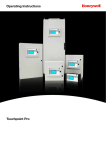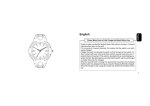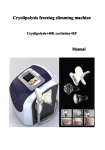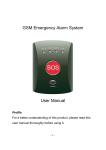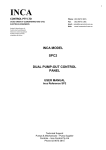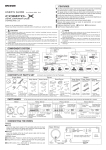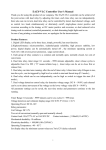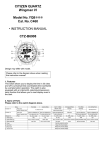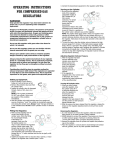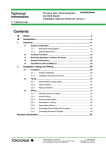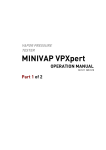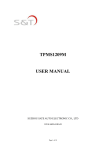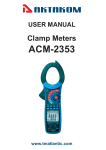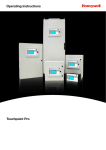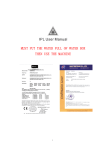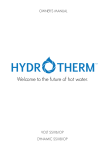Download View - INCA Control Pty Ltd
Transcript
1 INCA CONTROL PTY LTD Phone: Fax: UNIT 14/62 OWEN ST GLENDENNING NSW 2761 ELECTRICAL ENGINEERS (02) 9675 3815 (02) 9675 1381 Email: [email protected] Design & Manufacture of: Custom-built switchboards Electronic control equipment AC/DC pumping controls Installation & service INCA MODEL PV2 VARIABLE SPEED DRIVE CONSTANT PRESSURE CONTROLLER USER MANUAL Inca Reference PV2 Software Version 1.0 Technical Support Electrical & Controls – Inca Control Pty Ltd Phone 02 9675 1381 Inca Control Ref – 149…./8410 2 TABLE OF CONTENTS 1.0 2.0 3.0 4.0 5.0 6.0 7.0 8.0 9.0 Control Panel Overview………………………………………………. 1.1 Features………………………………………………………… 1.2 Description……………………………………………………... Installation…………………………………………………………….. 2.1 Mechanical installation………………………………………… 2.2 Sensor installation……………………………………………… 2.3 Electrical installation…………………………………………… 2.4 Maintenance…………………………………………………….. Start up………………………………………………………………… 3.1 Notes on value entry…………………………………………... 3.2 Power up display………………………………………………. 3.3 Screen display layout………………………………………….. 3.4 Operating the touch screen touch points………………………. 3.5 Pump starting…………………………………………………... Calibration……………………………………………………………. 4.1 Pressure Sensor Calibration……………………………………. 4.2 Setting low pressure shutdown………………………………… 4.3 Setting high Pressure shutdown..……………………………… 4.4 Setting the operational set point……………………………….. 4.5 PID Control Theory…………………………………………… 4.6 Modulating 1 or Both………………………………………….. 4.7 Wake up pressure………………………………………………. 4.8 Standby start speed…………………………………………….. 4.9 Stop min speed………………………………………………… 4.10 Low Stop Timer………………………………………………… 4.11 High Start Timer………………………………………………... 4.12 2nd Low Stop Timer…………………………………………….. 4.13 Auto Tuning…………………………………………………… Operation……………………………………………………………… 5.1 System operation……………………………………………….. 5.2 Manual/off/auto selectors………………………………………. 5.3 Duty Selector…………………………………………………… Variable speed drives………………………………………………….. 6.1 Manual override………………………………………………… Trouble shooting………………………………………………………. Controller settings sheet………………………………………………. Warranty Statement…………………………………………………… Drawing supplied separately 3 3 3 5 5 5 5 7 8 8 8 8 8 9 10 10 10 11 11 11 12 12 12 12 12 13 13 13 14 14 15 15 16 16 17 18 19 3 1.0 Control Panel Overview 1.1 Features Vision 350/570 user friendly colour touch Screen Display of system pressure Display of pressure set point Low pressure pump shutdown with flashing screen text Display of manual/off/auto Hour run meter for each motor (resetable) Microprocessor controlled PID loop control Variable speed controlled Useable with any 4-20mA loop powered Pressure Transducer Usable with any 415V centrifugal motor& pump combination 1.2 Description The pressure control panel is designed to maintain a constant system discharge pressure of an adjustable set point entered by the operator. The display shows the set point pressure required & the actual live pressure input received from the system discharge pressure transducer. These two numbers should general be around the same value. The system automatically alternates the pump motors each time the draw off required falls to a level at which a desired pressure has been reached & a minimum speed on the duty motor has also been reach for a time period. User Interface Display Keypad Information Performance Range Flow Graphical colour touch screen Display, 320 x 240 pixels (QVGA) 3.5” active area, Graphic TFT LCD. 256 colours. Operator keyboard, 5 sealed membrane keys & virtual touch pad screen for setting adjustments. View real-time system data. 0 – 1000kpa generally, programmable to suit transducer range. See pumping detail by pumps supplier. Inputs 2 wire plus shield connected to terminals located on panel base plate for pressure transducer & level transducers. Outputs Motors 3 wire plus earth overall screened sized to suit motor FLC connected directly to each variable speed drive 4 VFC output terminals. Proper shielding of motor cable on shield plate at drive. Voltage free contacts, relays outputs for each pump run/each pump fail/low discharge pressure/power on. Power Supply 415V 3phase neutral & earth power supply sized to suit the total load of all three motor & must have a protection circuit breaker sized to suit the starting characteristics of all motor starting simultaneously via reduced starting current variable speed drive controllers. Mechanical Specification Enclosure Mild steel powder coated RAL 7032 IP44 IP54 or stainless steel is available. Dimension Up to dual 2.2kW 600Hx400Wx300D 3kW to 7.5kW 600Hx600Wx300D 7.5kW to 15kW 800Hx600Wx300D Sizes may vary for specials. Pump Unit See Pumping detail pumps supplier. Environmental Specification Operating Temp -10 to 50deg C Relative Humidity Do not install in areas of high humidity. Location Located control panel internally where possible to help reduce heat & weather damage & increase mechanical life. The variable speed drives are heat emitting bodies Make sure to provide space & ventilation around cabinet to allow for cooling. Vibration Do not install in a location that is subject to large amounts of vibration. 5 2.0 Installation Note: If any damage to control panel is found, please notify Pumps Supplier or Inca Control & engineering as soon as possible prior to installation. The control panel can be wall mounted separately from the pumping unit up to distance of 30metres away. It is recommended that the control panel is within view of the pumping unit for safety reasons. If not in view lockable isolating switches must be installed at the pump motors. 2.1 Mechanical Installation Mount the control panel via the mounting holes in each corner at the back of the enclosure using minimum 6mm screws, nuts & locking washers. Install in a dry well ventilated location that matches with environmental specification in 1.2 above. 2.2 Sensor Installation Locate the pressure transducer in the pipe work as close as practical to the air pressure tank located on the pump discharge. This should help in smoothing out any sudden fluctuations in discharge pressure. 2.3 Electrical Installation Note: All cable entries must enter via the bottom of the cabinet. If cables are entered via the roof Inca Control & Engineering Pty Ltd reserve the right to withdraw warranty because of the possibility of shaving entering sensitive electronic equipment. Transducer wiring The pressure transducer must be wired in 1 pair overall screened data cable. This type of cable provides the most protection against electrical noise that is generated by the variable speed drives. Connect to the sensor as per data supplied by the sensor supplier or figure 1 below. At the control panel connect the positive lead to the 24V supply (generally terminal No10) & the return signal to PLC side of the circuit (generally terminal No11). The screen must be solidly earthed, with a saddle clamp or earth terminal for best screening. 6 FIGURE 1 Motor Wiring The motors must be wired in overall screened power cabling sized to suit the motor power requirement. This type of cable provides the most protection against the emitting electrical noise produced by the Variable speed drive. If the correct cable is not installed the installation will not comply with the C tick regulation & radio waved could become interfered with which could cause radios & television reception to become distorted. The motors are to be connected in star or delta as instructed by the nameplate on the motor. The cabling entering into the motor terminal box shall be glanded using EMC type glands to provide good earthing of the cables overall screen. The cable entering the control panel end can be glanded using standard nylon glands & run directly to the appropriate variable speed drive where the screen will be earth on the special earthing plate at the bottom of the drive terminals via an earthing saddle. The motor cable are connected into the output terminals on the drive U/T1, V/T2, W/T3 as shown in figure 2 below. FIGURE 2 7 2.4 Maintenance The only general maintenance required to the control panel is to clean or replace the air inlet & outlet filter. Inlet filters must be cleaned or replaced every 6months & more often under high dust conditions. Outlet filters can be cleaned & replaced as required while cleaning of the Inlet filter occurs. Failure to carry out regular cleaning of filters will reduce the operating life of the control equipment. 8 3.0 Start up 3.1 Notes on Value Entry When entering a numeric value, the cursor can be backspaced to correct mistakes by pressing the LEFT ARROW button. Decimal points can only be entered on entries with decimal points in the display line. The decimal point is entered by pressing the button on the bottom right corner of the numeric entry buttons You can only enter a value of as many digits as is displayed on the screen. Example an input that displays 3 digits can only have 3 digit entered. 3.2 Power Up Display On power up the screen will display information & contact details for Inca Control Pty Ltd. This information is displayed for 10seconds before moving onto the MAIN PAGE which displays the pressures, switches & operating information. 3.3 Screen Display Layout The main page displays the basis of all operation that is happening in the system. At the top left of screen in bold letters is the SET PRESSURE. This is the pressure the system is trying to maintain & is displayed in kPa. At the top right of screen in bold letters is the SYSTEM PRESSURE. This is the live signal from the discharge pressure transducer & is displayed in kPa. Directly below the set pressure is the DUTY SELECTOR. This text is within a box & touching the screen within that box will transfer to the Duty Selector page. On this page the sequence of the pumps can be selected. Directly below the System Pressure is the LOW PRESSURE alarm display. Under normal operating conditions this area of the screen will be blank, but if pressure in the discharge line falls to below the Low Pressure set point then LOW PRESSURE will be displayed and flashing. The pumps will be shutdown. This alarm is reset when the pressure is jacked up above the Low Pressure reset set point. Below the duty selector & low pressure alarm are the MAN/OFF/AUTO selectors for each pump with the status of the associated pump located just above the MAN touch point. Below the AUTO touch point for each pump is text that identifies which position the associated man/off/auto has been selected to, the % of speed the motor is running at & the hours the pump has run in total. 3.4 Operating The Touch Screen Touch Points Operating the touch screen is as simple as it sounds. All touch point are displayed by having the appropriate text enclosed by a box & simply touching within the box will operate the appropriate operation. 9 3.5 Turning the Pumps On Initial turn on of the pumps should be carried out in manual. Select the appropriate pump to manual (see section 5.2 below on manual operation), & jack the system up to the approximate pressure set point required. Once the system seems stable turn the pumps onto auto & calibrate as per section 4 below. 10 4.0 Calibration The calibration of the controller is carried out on pages accessed by pressing & holding in the F1 button on the bottom left of the controller face for 5seconds. The first calibration page will appear. You can move through the calibration pages by pressing the NEXT PAGE touch point or adjust the settings as required by touching on the setting to be changed which will take you to a virtual enter screen. Each input value is recorded once the enter button has been pressed. The enter button is the return arrow located at the bottom right corner of the number buttons. To get out of calibration pages press the NEXT PAGE touch point on each page until the MAIN PAGE is displayed. 4.1 Pressure Sensor Calibration Sensor 0% = the value in engineering terms related to the field device feedback signal. The pressure transducer sends a 4-20mA signal to the controller. This signal needs to be displayed in kPa to mean something to the operator. The Sensor 0% is the engineering value when the transducer is at its lowest value (i.e., 4mA) & will be factory set at 0kPa. This value can be altered to suit different applications as required. Example 250kPa. Enter the setting screen, press 2 press 5 press 0 & then press enter. You now have entered 250kPa for Sensor 0%. Sensor 100% = the value in engineering terms related to the field device feedback signal. The pressure transducer sends a 4-20mA signal to the controller. This signal needs to be displayed in kPa to mean something to the operator. The Sensor 100% is the engineering value when the transducer is at its highest value (i.e., 20mA) & will be factory set at 1000kPa. This value can be altered to suit different applications as required. Example 900kPa. Enter the setting screen, press 9 press 0 press 0 & then press enter. You now have entered 900kPa for Sensor 100%. 4.2 Setting Low Pressure Shutdown To adjust Low pressure stop there are 3 entry values. LOW PRESSURE ON setting. Enter the setting screen & simply type in the appropriate pressure you want the low pressure shutdown to operate at, example 200kPa. Enter the setting screen Press 2, press 0, press 0 & then press enter. LOW PRESSURE OFF setting. Enter the setting screen & simply enter in the appropriate pressure you want the system to restart at. This will reset the low pressure alarm & allow the pumps to operate in automatic. Example 250kPa. Enter the setting screen press 2 press 5 press 0 & then press enter. LOW PRESSURE TIME setting. Enter the setting screen & simply enter in the appropriate time delay you want before the system will shutdown once the 11 pressure is below your low pressure on setting. Example 30seconds. Enter the setting screen press 0 press 0 press 3 press 0 & then press enter. You now have entered 200kPa low pressure alarm with a delay of 30seconds & a reset of 250kPa. 4.3 Setting High Pressure Shutdown To adjust high pressure stop there are 3 entry values. HIGH PRESSURE ON setting. Enter the setting screen & simply type in the appropriate pressure you want the high pressure shutdown to operate at, example 800kPa. Enter the setting screen Press 8, press 0, press 0 & then press enter. HIGH PRESSURE OFF setting. Enter the setting screen & simply enter in the appropriate pressure you want the system to restart at. This will reset the high pressure alarm & allow the pumps to operate in automatic. Example 750kPa. Enter the setting screen press 7 press 5 press 0 & then press enter. HIGH PRESSURE TIME setting. Enter the setting screen & simply enter in the appropriate time delay you want before the system will shutdown once the pressure is below your high pressure on setting. Example 30seconds. Enter the setting screen press 0 press 0 press 3 press 0 & then press enter. You now have entered 800kPa low pressure alarm with a delay of 30seconds & a reset of 750kPa. Touch the next page touch point to move onto the next page. 4.4 Setting The Operational Set Point The Set Point & PID Page will now be displayed. Enter the setting screen for set point To enter your required pressure say 600kPa press 6, press 0, press 0 press enter. You have now entered 600kPa as the operational set point. The PID figures are set during auto tune & are not adjustable in this location. 4.5 PID Controller Theory The pumping system is controlled via a PID loop controller (Proportional, Integral, & Derivative) is used to control devices, such as drives to maintain control of a varying system This is in most cases done through the examination of signals from sensors placed in the system, called feedback signals. When the feed back signal is received, it is compared with desired value or set point (i.e. our 600kPa set point above). Based on this comparison a calculation of what the necessary response is, in order to make the feedback signal match the set point. The next three setting below Set Point on the Set Point & PID page (Prop Band, Integral Time, & Derivative Time) do not require adjusting as these parameters will be tuned as required during the auto tune process in 4.12 below. 12 4.6 Modulating 1 or both pumps The pumping system can be set to modulate 1 or both pump as required. If only 1-off pump is modulating the other will be locked in at full speed if a second pump is required. If both pumps are set to modulate then when the second pump is called to run both pumps will ramp up & down until the second pump is not required. To select modulating 1 or both simply touch on the box marked modulating 1 & it will change to modulating both & vice versa. Touch the next page touch point to move onto the next page. 4.7 Wake-up Pressure The wake-up pressure is the value at which the system will restart after entering sleep mode. This value must be set lower than the Set point value. The system will automatically turn off & go into sleep mode if the Set Point has been reached - 5kPa + 20second of maintaining this value. The Pump Profile page will now be displayed. To set wake-up pressure to 575kPa. Enter the setting screen press 5, press 7, Press 5, press enter. The wake-up pressure is now set at 575kpa. 4.8 Standby Start Speed Standby Start speed is the speed at which the standby pump will be called to start after the duty pump has reached this speed plus a set time delay. This speed is factory set at 100% (full speed) but can be adjusted to be lower if required say 90%. Enter the setting screen press 9, press 0, press enter. The standby start speed is now set at 90%. 4.9 Pump Stop Minimum Speed The pump stop minimum speed is the speed at which the standby pump is turned off after the duty pump has reached the pump stop minimum speed plus a short time delay. This set point is critical to be set correctly so as to prevent short cycling. To set the Pump stop Min Speed you must first operate 1-off pump in manual with a closed discharge to find out the pump speed required to maintain set point pressure. Add 2% to ensure the system will get to the setpoint. This speed value is then entered. Example say 67%. Enter the setting screen press 6, press 7, press enter to accept. The pump stop min speed is now set to 67%. 4.10 Low Stop Timer The low stop timer is the time delay added to the sleep mode shut-off pressure. This timer is required to help prevent short cycling when there is minimal draw off. This time is factory set at 20seconds. This time is displayed in minutes & seconds. To set a time of 40seconds enter the setting screen press 0, press 0, press 4, press 0 press enter to accept. You have now set 40second as low stop time. 13 4.11 High Start Timer The high start timer is the time delay added to the standby pump start to ensure that the pressure is still falling before starting the standby pump. This timer is required to help prevent short cycling when there is minimal draw off. This time is factory set at 2seconds. This time is displayed in minutes & seconds. To set a time of 5seconds enter the settings screen press 0, press 0, press 0, press 5 press enter to accept. You have now set 5second as high start time 4.12 2nd Low Stop Timer The 2nd Low Stop timer is the time delay added to the standby pump stop to ensure that the pressure is still rising or steady above the set point pressure before stopping the standby pump. This timer is required to help prevent short cycling when there is minimal draw off. This time is factory set at 1seconds. This time is displayed in minutes & seconds. To set a time of 5seconds enter the settings screen press 0, press 0, press 0, press 5 press enter to accept. You have now set 5second as high start time General calibration is now complete. Press the Next Page touch point to return to the main page 4.13 Auto Tuning After setting all the calibration setting above (which may need small adjustments once auto tuning has been carried out), carry out an auto tune which will set up the controller PID parameters to suit the live input from the field pressure transducer. It is critical that the following is observed: 1) Make shore pump is running at set point pressure & is not wanting to call other pump online. 2) Use only one pump in automatic, Turn the remainder off. Auto tuning takes from 5 to 20 seconds & is a three stage process To carry out an auto tune press& hold the F4 button for 5seconds or the Auto Tune Button the display will flash AUTO-TUNE IN PROGRESS until auto tune is complete. During this time you can not access other screens. 14 5 Operation 5.1 System Operation The system is designed to maintain a constant pressure in the discharge line of a pumping system. The duty pump will start & ramp up & down in speed maintaining the set point pressure until this duty pump reaches & maintains 100% speed for a short time delay. At this point this pump will be locked in at full speed & the first standby pump started. The first standby pump will then ramp up & down maintaining the set point pressure until either this pump reaches & maintains 100% speed for a short time delay. At this point the second standby pump will be started & ramp up & down maintaining set pressure. If the second standby pump reaches the & maintains the pump stop criteria, it will be turned off & the first standby pump will then be release & ramp up & down to maintain the set point pressure. If the first standby pump reaches & maintains the pump stop criteria, it will be turned off & the original duty pump will then ramp up & down to maintain the set point pressure until this pump reaches & maintains the pump stop criteria plus a delay for 20seconds & will then turn off stopping all pump operation until the wake-up pressure is again reached. The pressure will fall to the wake-up pressure set point where the duty pump will then start the cycle once again. Each time the system goes to sleep the duty pump will be alternated to the next pump ready for the next operation. If a motor fails the first standby pump will be started & will remain as duty until the faulted pump is put back on line. Pump Stop Criteria Duty Pump – The duty pump requires 3 things to shut down1. 2. 3. The system pressure has reached & maintains set point pressure less 5kPa. The motor speed is less & maintains less than the speed set in PUMP STOP MINIMUM SPEED parameter (4.9 above) And the time value entered into LOW STOP TIMER parameter (4.10 above) has timed out. Standby Pump – The standby pump requires 3 things to shut down1. 2. 3. The system pressure has reached & maintains set point pressure less 5kPa. The motor speed is less & maintains less than the speed set in PUMP STOP MINIMUM SPEED parameter (4.9 above) And the time value entered into parameter SECOND LOW STOP TIMER parameter (4.12 above) has timed out. 15 5.2 Manual/Off/Auto Selector Switches Each pump has a Manual/Off/Auto selector switch. Each function of the switch is selected by touching on the operation. Manual Off Auto Touching the MAN box will turn the pump on & display UP & DOWN arrows next to the MAN box. The pump will not run until the UP arrow is pressed & the speed increased to the desired speed. Pressing the DOWN arrow will decrease the speed. Below the auto box will be text advising that MAN has been selected & the % speed the motor is running at. Touching the OFF box will turn the pump off. Below the Auto box will be text advising the switch is selected to off. Touching the AUTO box will select the pump on automatic & is then controlled via the PID loop controller. Below the auto box will be text advising that AUTO has been selected & the % speed the motor is running at. 5.3 Duty Selector The duty selector allows the operator to select a given pump alternating pattern or automatic alternation. If the system is selected to auto & a pump fails the controller will select the appropriate pump pattern that leaves the faulty pump as last selected. I.e., Pump 2 is the duty pump with the system selected to automatic alternation. If Pump 2 fails the automatic sequence will become Pump 3 Duty, Pump 1 standby, Pump 2 2nd standby, (although Pump 2 will not operate because it is tripped out on fault). To select the alternation pattern touch on the DUTY SELECT box on the main page. You will now be in the duty selector page. At the top centre of the page will be the identification of which sequence has been selected I.e., Automatic, 12, 21. To select a sequence simply touch on the box displaying the appropriate sequence. The selected sequence will now be displayed at the top of the page. Note, if a pump is in fault a manual selection of alternation must not be carried out. Once fault condition has been rectified automatic sequence can again be manually selected. 16 6 Variable Speed Drives The Variable speed drives used on this pumping unit are Toshiba VFS11 series. The VSD will drive the pump motor at changing speeds controlled via the PLC controller. The varying pump speed will maintain a constant system pressure on the discharge line. The VSD has a vast number of internal parameter, that has been factory set & do not require any adjustment or fine tuning. Any adjustments should be made as per section 4 above & within the PLC controller. 6.1 Manual Override The pumps can be run in a manual override arrangement in the event of a PLC failure or at any time as required. Inside the control panel are switches marked MANUAL OVERRIDE. Selecting the appropriate switch to override will shutdown the automatic control from the PLC controller & allow manual control directly from the face of the selected VSD. Press the RUN button on the VSD to start the pump. The pump speed is now controlled via the Speed pot on the front of the drive. Turning this dial in a clockwise direction will increase the speed & turning in an anticlockwise direction will decrease the pump speed. Pressing the stop button on the face of the drive will turn the pump off. Note, It is best if the speed pot dial is turn fully anticlockwise when turned off so as when selected to run next time it does not ramp to full speed or where ever the pot dial was last left & will have better control for the operator. Turn the override switch back to normal operation so as the pump is again controlled automatically by the PLC. 17 7 Trouble Shooting Condition 1. Unit does not power up. Do This Check that power supply is on to panel and isolator is on. Check that control circuit breaker is on. 2. PLC Controller does not power up Check that 24VDC power supply is but power is on. operating, & power supply plug on PLC controller is fully inserted. 3. VSD does not power up. Check that all pump circuit breakers are on Check that control circuit breaker is on. 4. Pump Fail displayed on screen. Reset VSD by turning associated pump circuit breaker off for 10seconds & then back on. If fault continues take note of the code in the VSD display & call for service 5. VSD screen displaying fault OH Check air inlet filter clean & not (overheat). blocked Check cooling fan is operating & not failed. Reset fault by turning pump circuit breaker off for 10 seconds & then back on. If fault continues call for service 6. System Produces a Low Pressure Select a pump to manual & jack shutdown. system up to operating pressure. Reselect back to auto. Check that mains water is available & all valves are open 7. Pressure displaying a negative Pressure transducer has open circuit value. 4-20mA loop or is faulty. Check pressure transducer cabling connections, replace transducer with the same unit or call for service 8. Pressure discharge unstable. Perform auto tuning as per section 4.12. Check air pressure. Pressure vessel should be approximately 70% of the set point pressure. 8. Problems with pumps. Refer to pump manual or contact Pump supplier for service 18 8 Controller settings sheet Parameter Description Low pressure Shutdown Pressure at which pumps are shutdown for low discharge pressure Pressure at which pumps are reset after a low discharge pressure shutdown System set point pressure that is to be maintained Low pressure Reset Set Point Sensor 0% Sensor 100% 200kPa 250kPa 600kPa The Low Value of the Transducer input 0kPa The High Value of the Transducer input 1000kPa Wake Up Pressure Pressure setting at which the sleeping pumps are turned back on Standby start The speed of the pump at speed which the next pump is call on line to maintain set pressure Stop Minimum The speed of the duty Speed pump at which the standby pump is told to stop Low Stop Timer The time delay to shutdown duty pump once set pressure & stop min speed reached High Start Timer The time delay before starting the standby pump 2nd Low Stop Timer Factory settings The time delay before stopping the standby pump 575kPa 100% 75% 20second 2seconds 1seconds User Setting 19 9.0 Warranty Statement The Products manufactured by Inca Control Pty Ltd is guaranteed against faulty workmanship for a period of 12 months from the date of delivery. Our obligation assumed under this guarantee is limited to the replacement of parts which, by our examination are proved to be defective & have not been misused, carelessly handled, defaced or damaged. This guarantee is VOID where the purchaser has modified or repairs have been made or attempted by anyone except an authorised representative of Inca Control Pty Ltd. Products for attention under guarantee (unless otherwise agreed) must be returned to the factory freight paid and, if accepted for free repair, will be returned to the customers address in Australia free of charge. Equipment supplied by Inca Control Pty Ltd, but manufactured by others is covered by their manufacturers warranty only. When returning the product for service or repair, a full description of the fault must be given and the mode of operation used when the product failed. In addition to the above, equipment manufactured, installed & commissioned by Inca Control Pty Ltd, within the Sydney Metropolitan Area, includes onsite replacement. In any event Inca Control Pty Ltd has no other obligation or liability beyond replacement or repair of this product. NOTES:



















